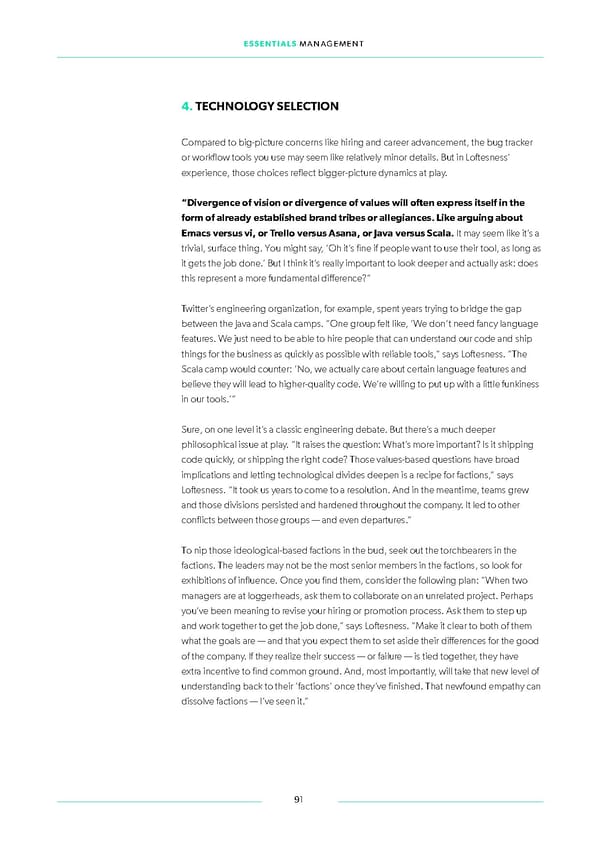ESSENTIALS MANAGEMENT 4. TECHNOLOGY SELECTION Compared to big-picture concerns like hiring and career advancement, the bug tracker or worklfow tools you use may seem like relatively minor details. But in Lotfesness’ experience, those choices relfect bigger-picture dynamics at play. “Divergence of vision or divergence of values will otfen express itself in the form of already established brand tribes or allegiances. Like arguing about Emacs versus vi, or Trello versus Asana, or Java versus Scala. It may seem like it’s a trivial, surface thing. You might say, ‘Oh it’s ifne if people want to use their tool, as long as it gets the job done.’ But I think it’s really important to look deeper and actually ask: does this represent a more fundamental difference?” Twitter’s engineering organization, for example, spent years trying to bridge the gap between the Java and Scala camps. “One group felt like, ‘We don’t need fancy language features. We just need to be able to hire people that can understand our code and ship things for the business as quickly as possible with reliable tools,” says Lotfesness. “The Scala camp would counter: ‘No, we actually care about certain language features and believe they will lead to higher-quality code. We’re willing to put up with a little funkiness in our tools.’” Sure, on one level it’s a classic engineering debate. But there’s a much deeper philosophical issue at play. “It raises the question: What’s more important? Is it shipping code quickly, or shipping the right code? Those values-based questions have broad implications and letting technological divides deepen is a recipe for factions,” says Lotfesness. “It took us years to come to a resolution. And in the meantime, teams grew and those divisions persisted and hardened throughout the company. It led to other conlficts between those groups — and even departures.” To nip those ideological-based factions in the bud, seek out the torchbearers in the factions. The leaders may not be the most senior members in the factions, so look for exhibitions of inlfuence. Once you ifnd them, consider the following plan: “When two managers are at loggerheads, ask them to collaborate on an unrelated project. Perhaps you’ve been meaning to revise your hiring or promotion process. Ask them to step up and work together to get the job done,” says Lotfesness. “Make it clear to both of them what the goals are — and that you expect them to set aside their differences for the good of the company. If they realize their success — or failure — is tied together, they have extra incentive to ifnd common ground. And, most importantly, will take that new level of understanding back to their ‘factions’ once they’ve ifnished. That newfound empathy can dissolve factions — I’ve seen it.” 91
 Essentials Management First Round Capital Page 90 Page 92
Essentials Management First Round Capital Page 90 Page 92